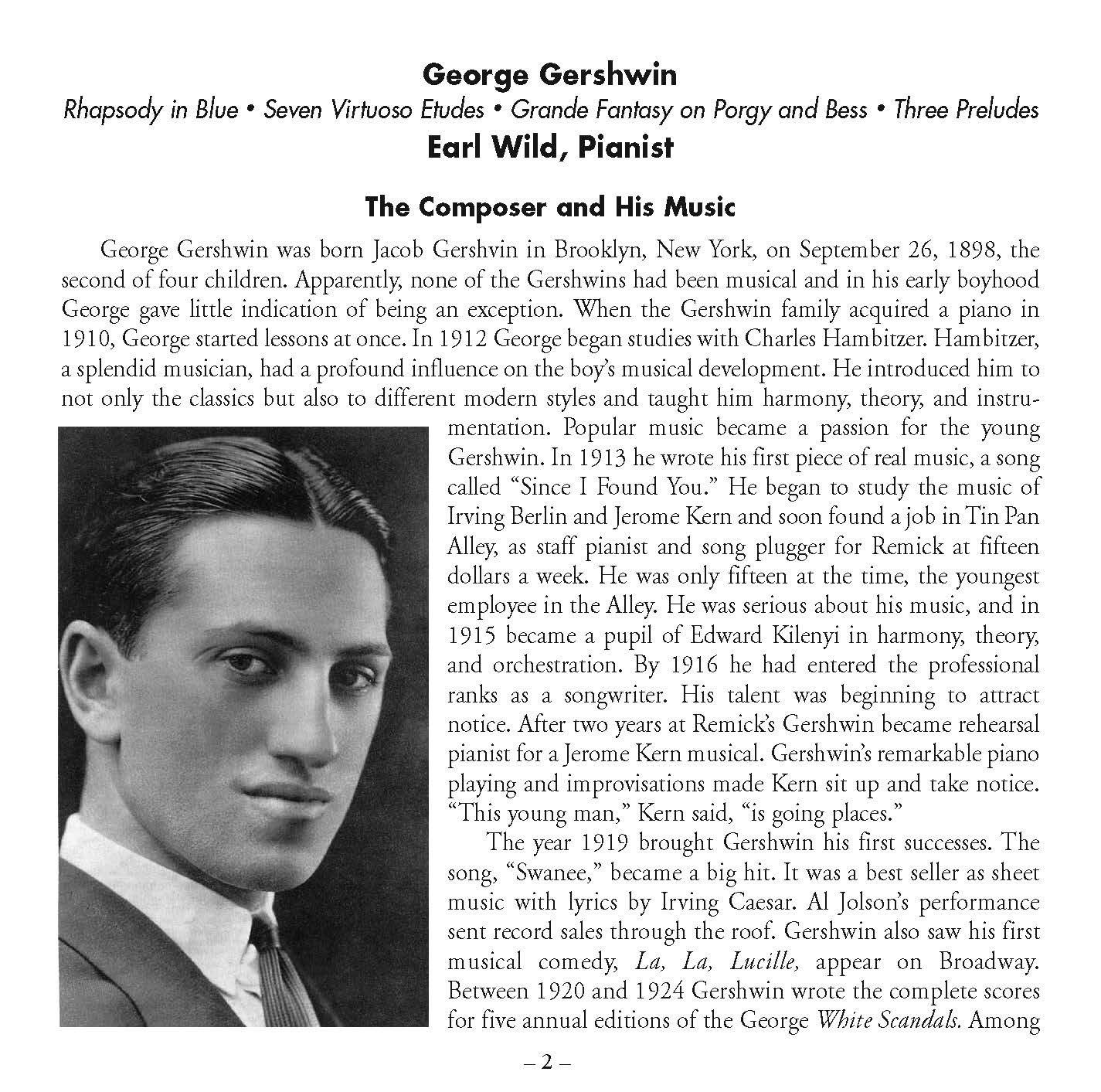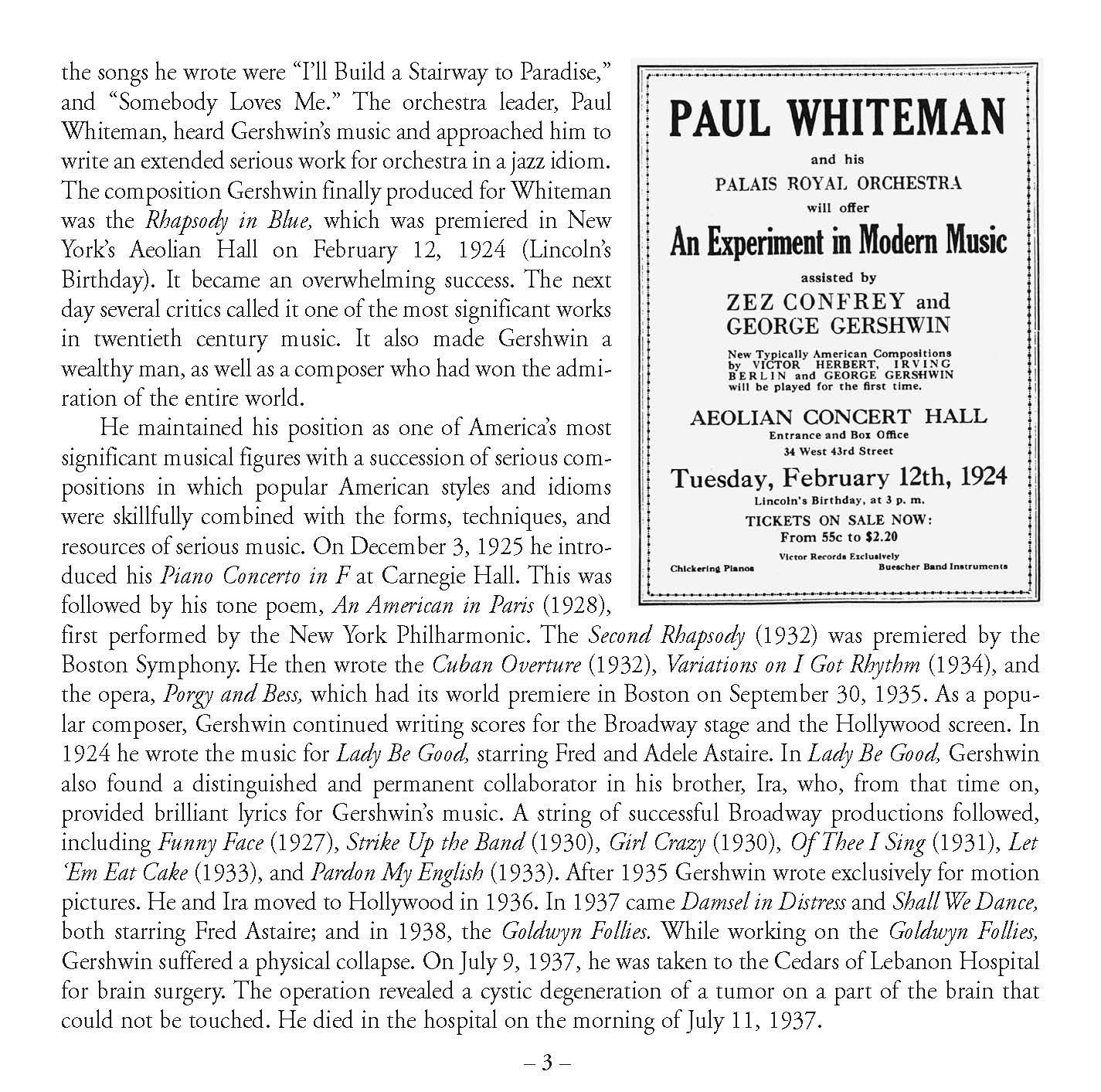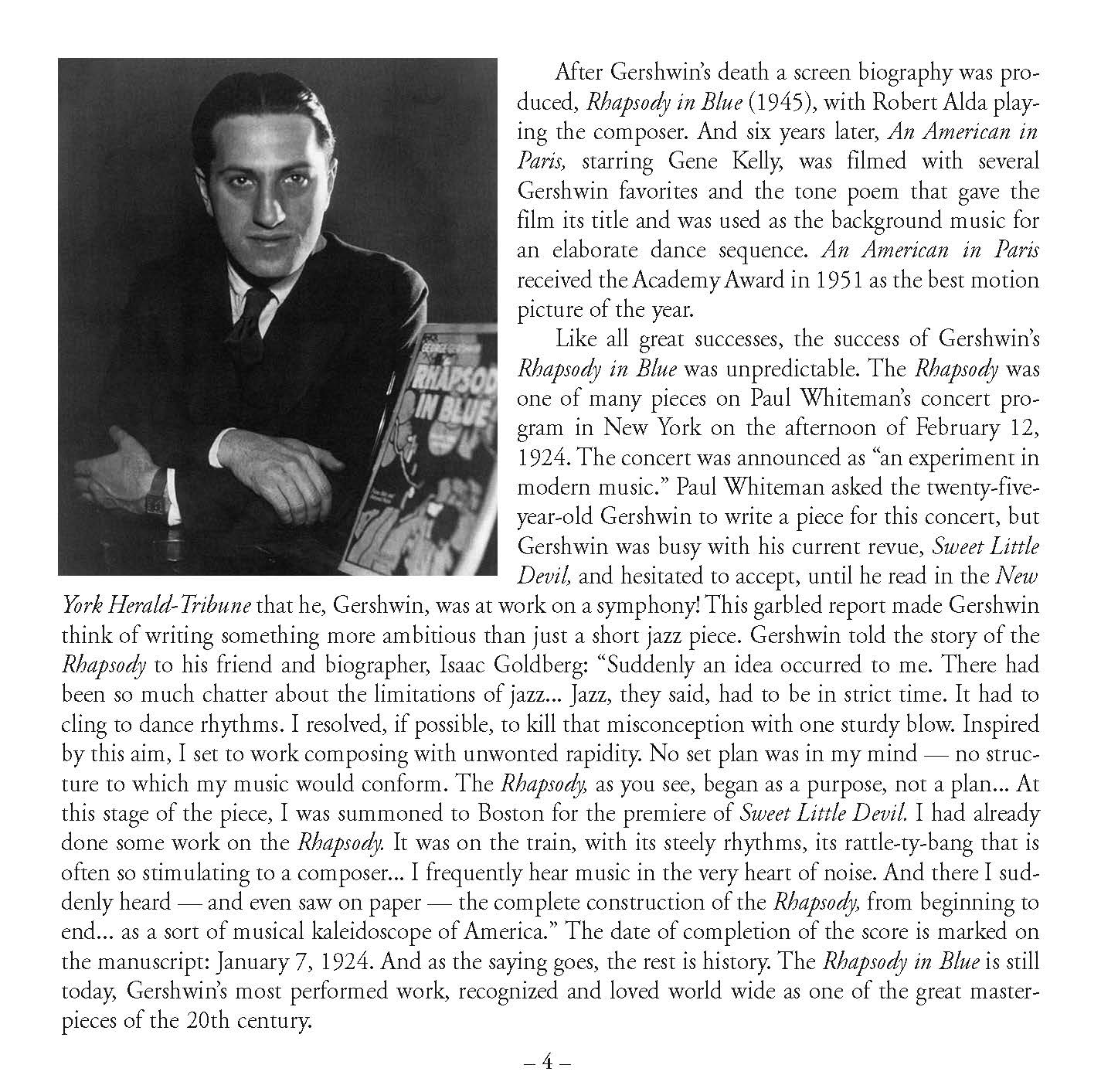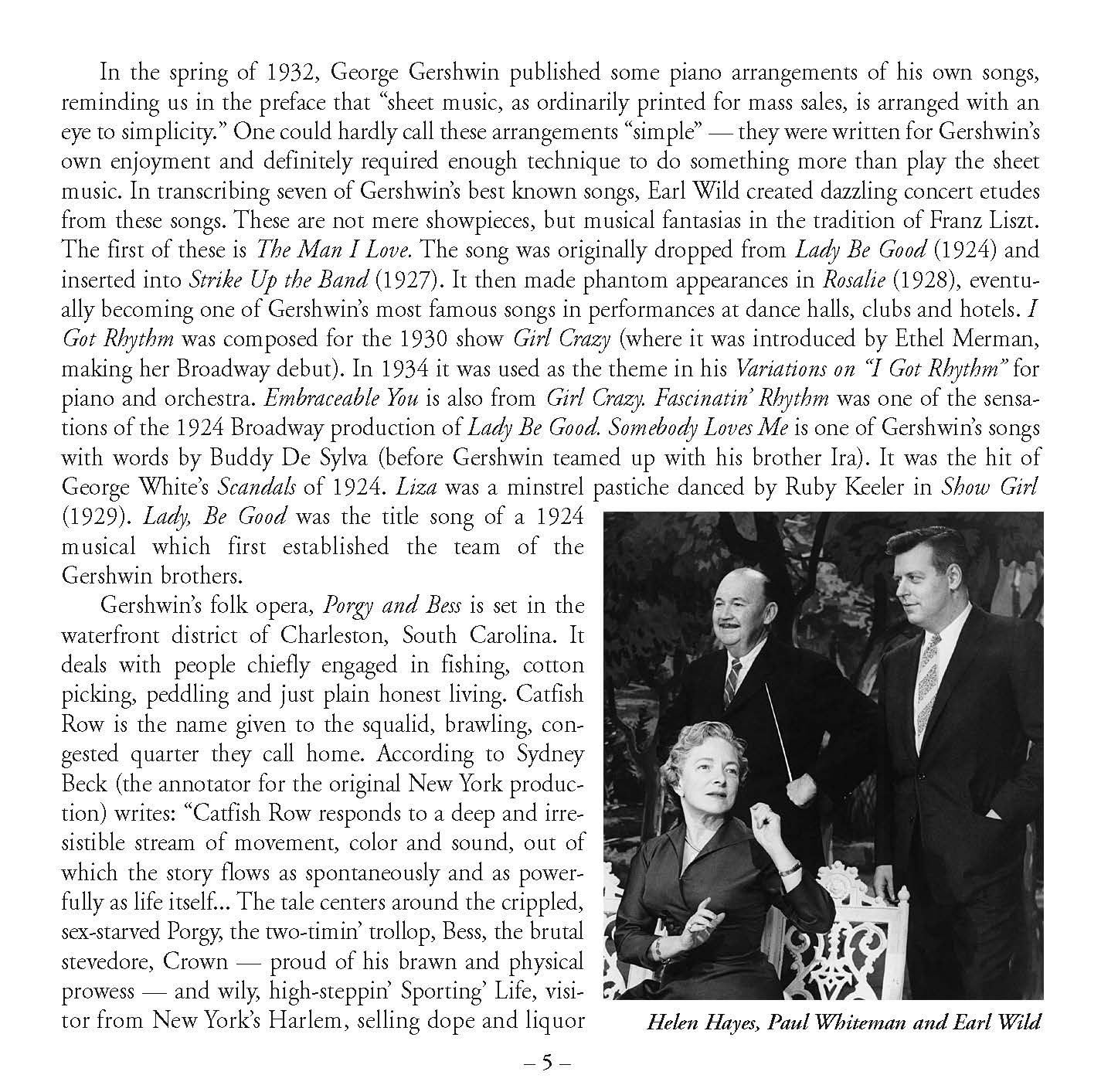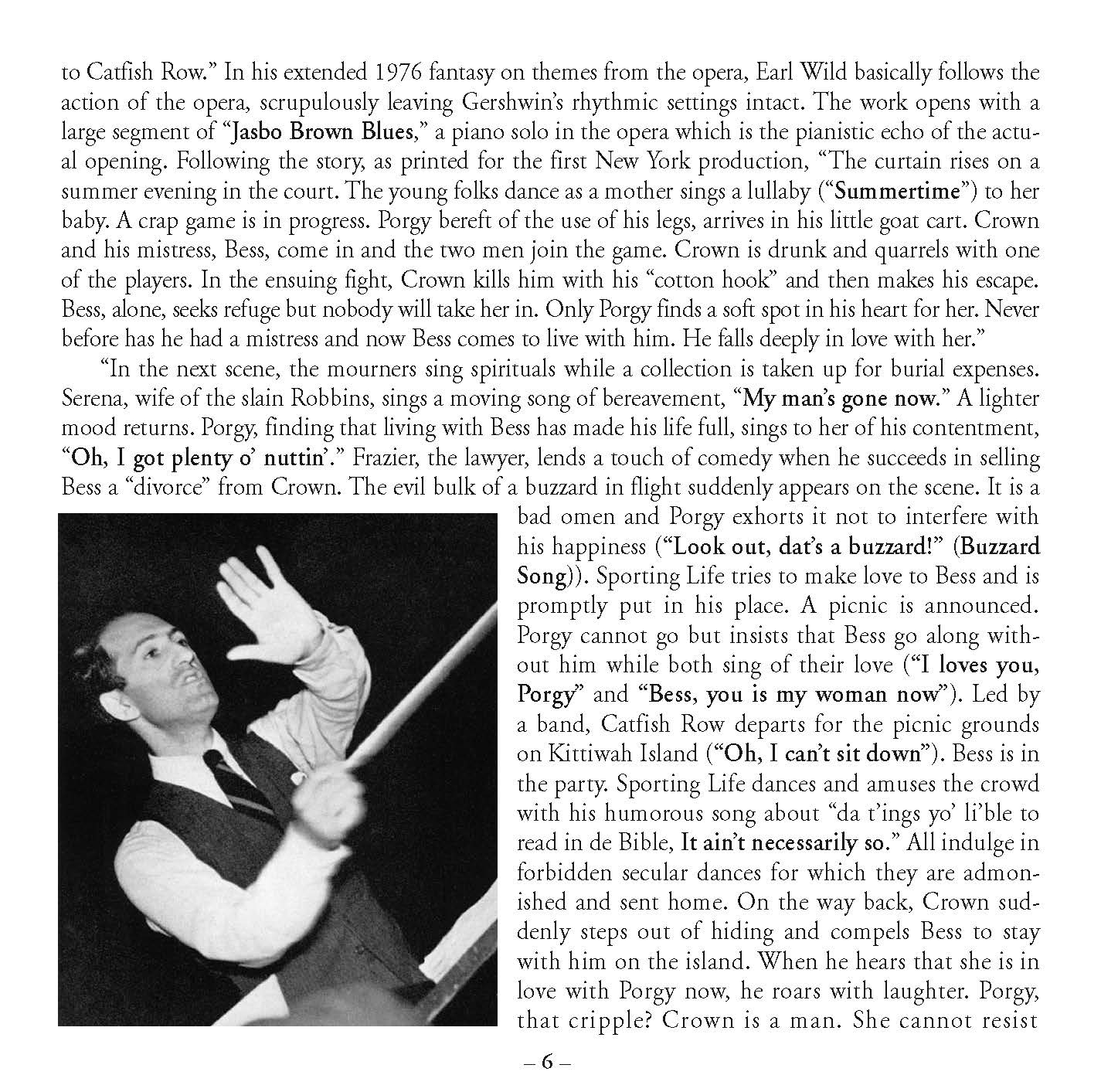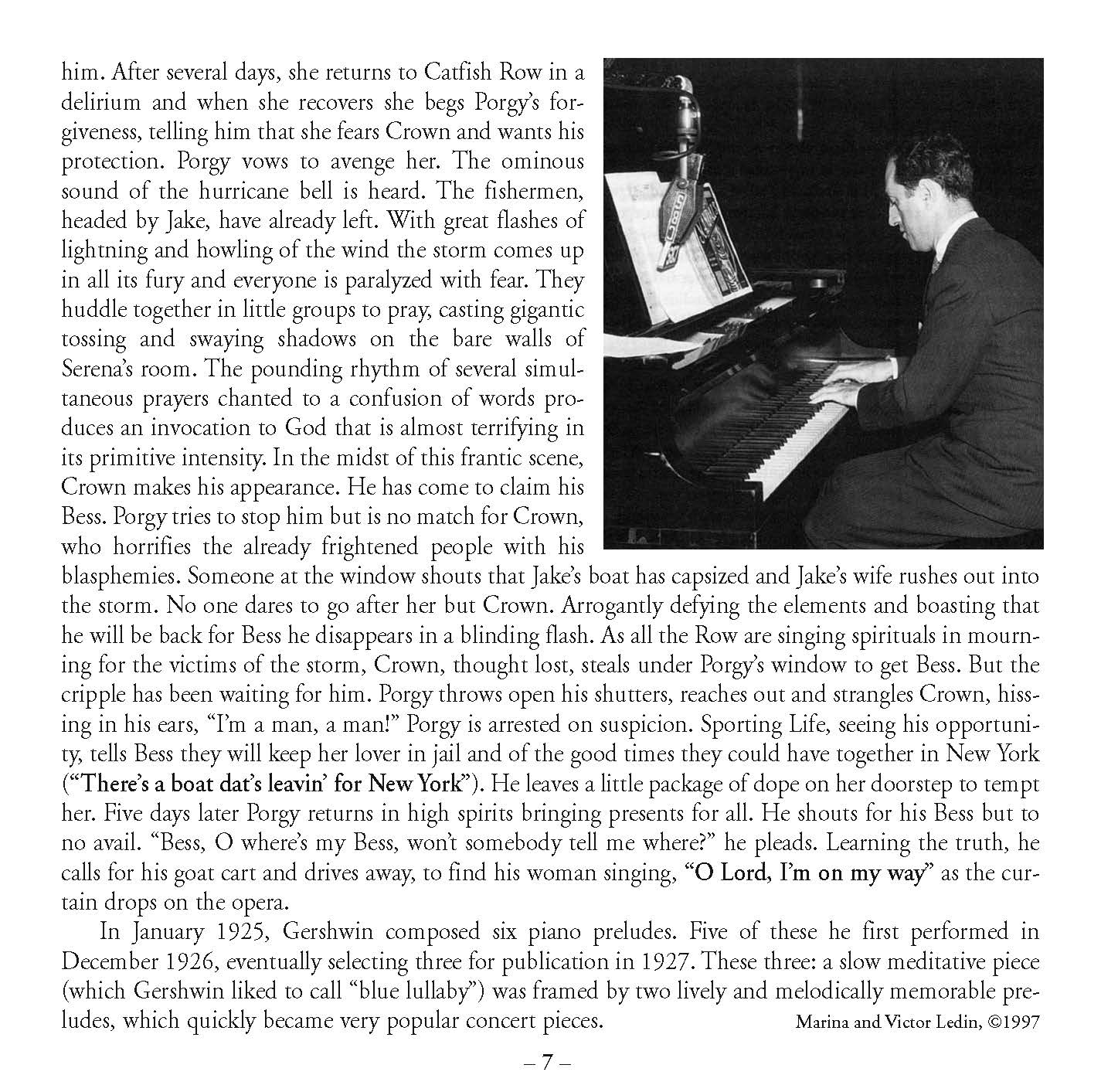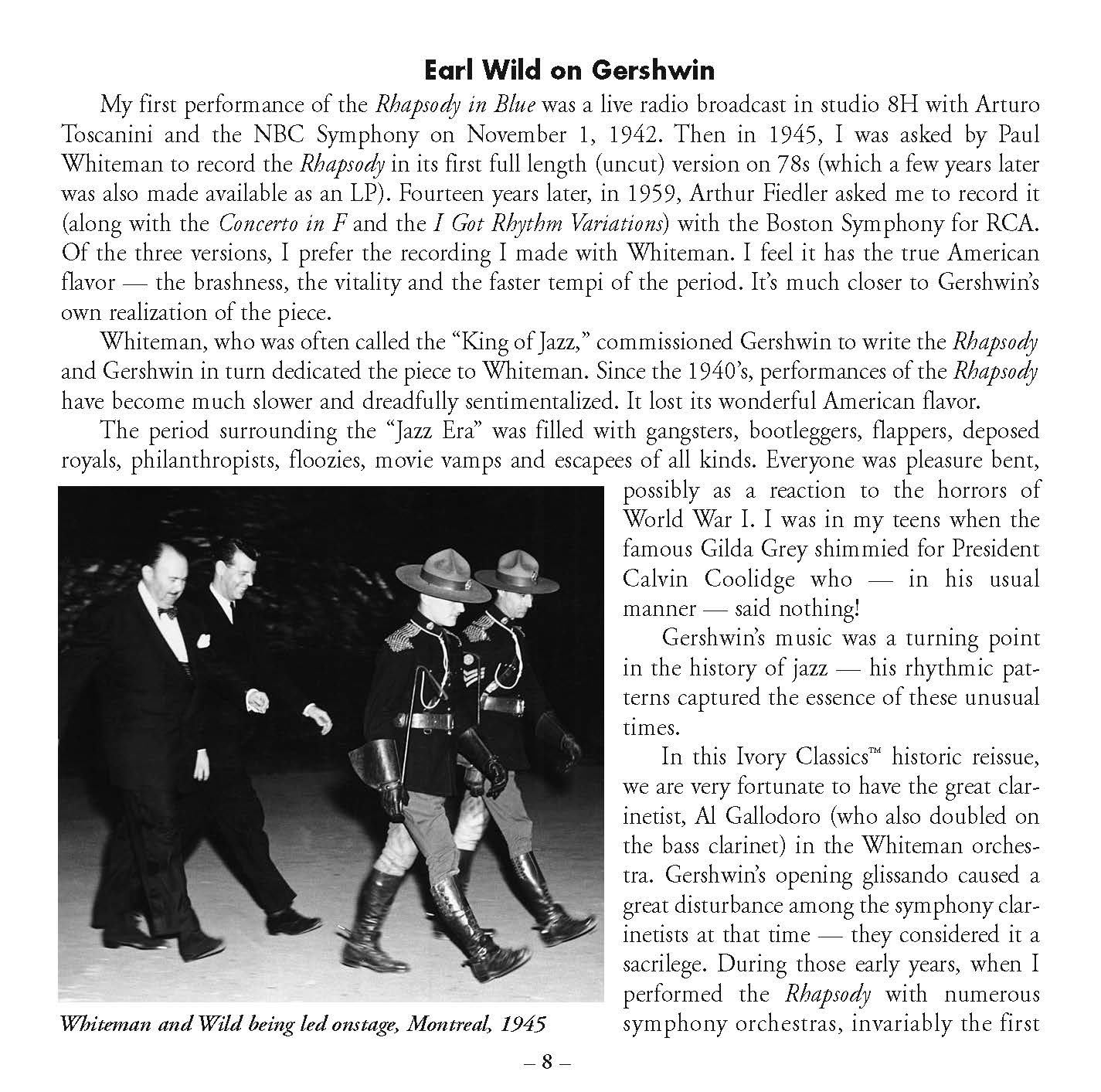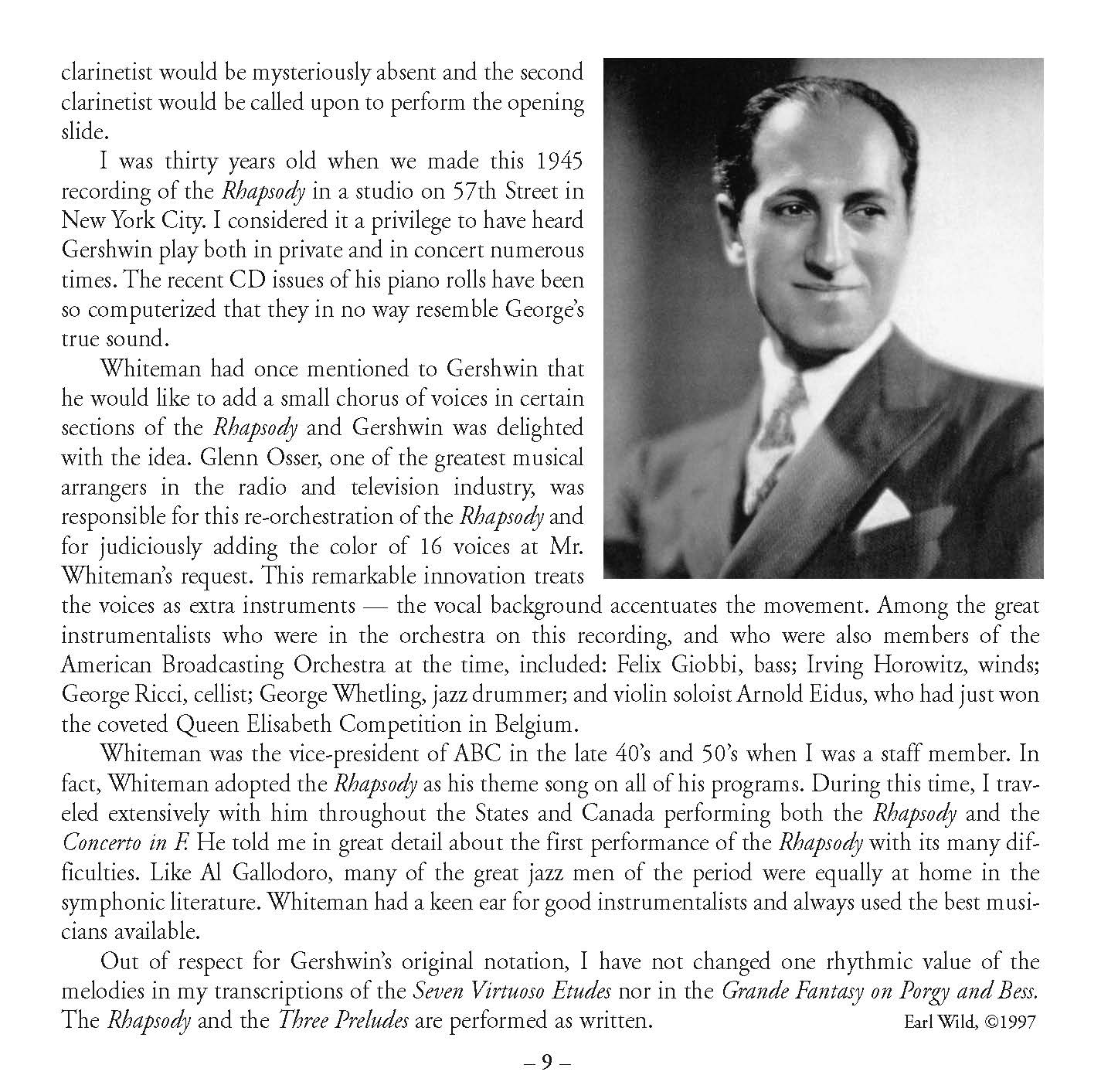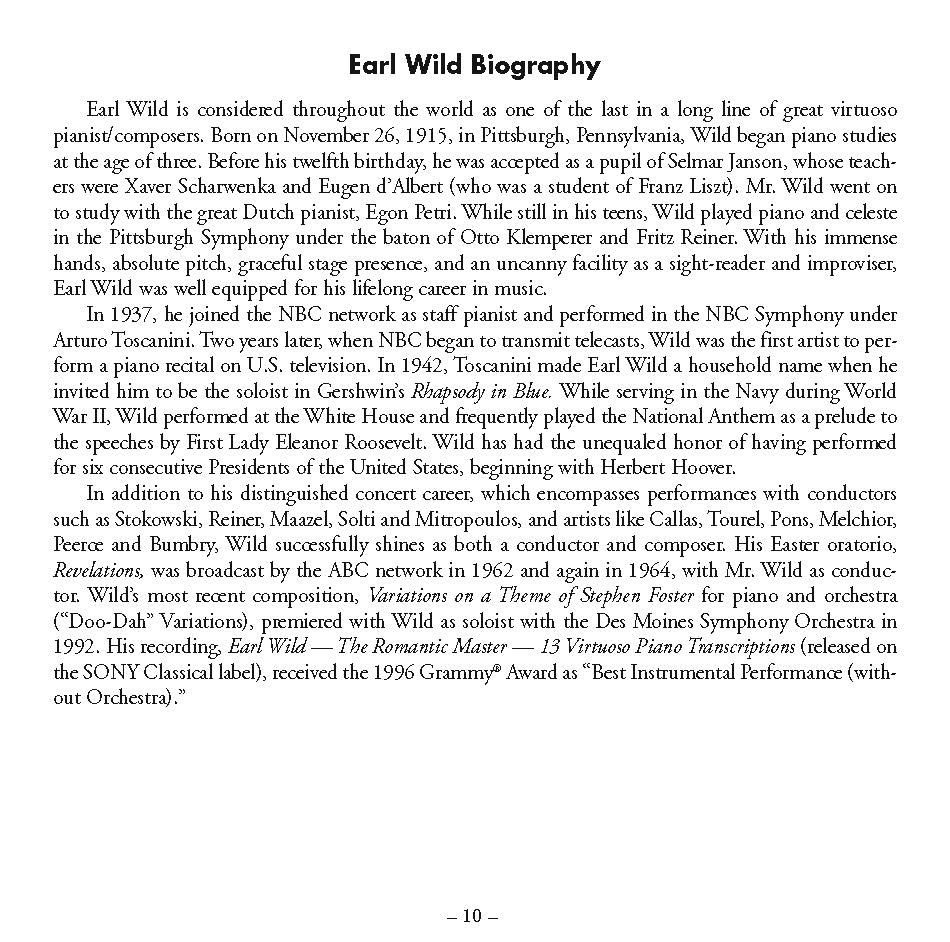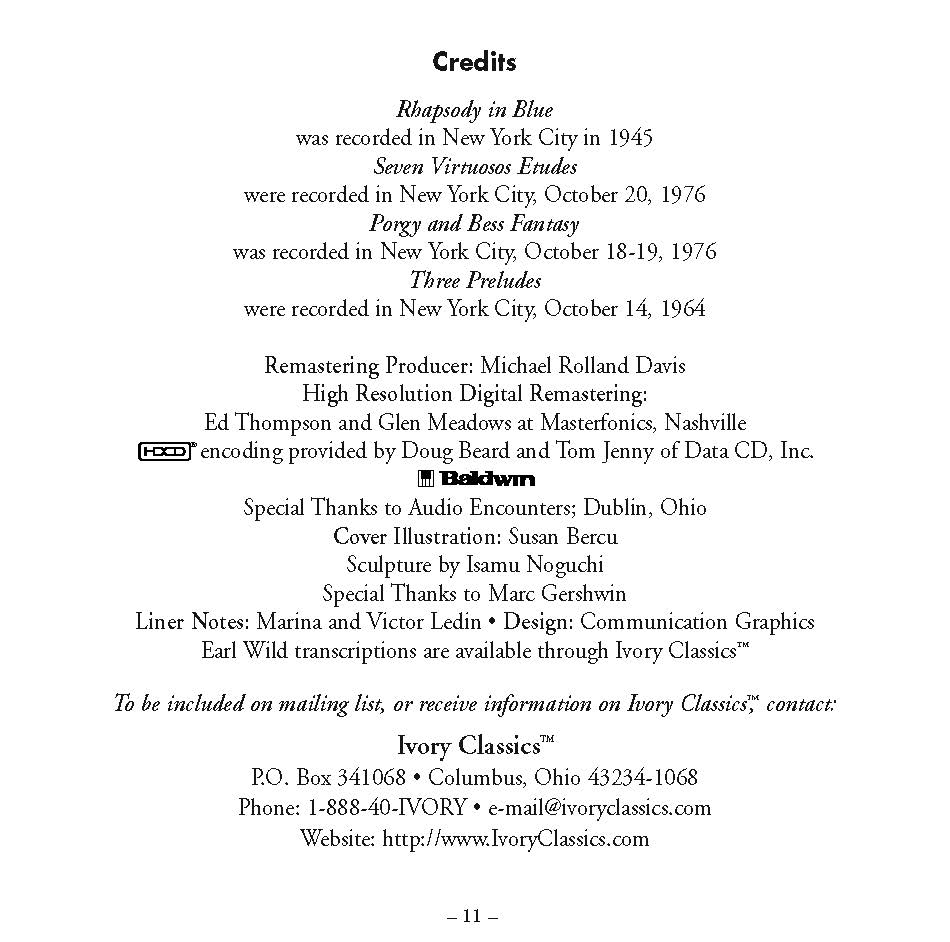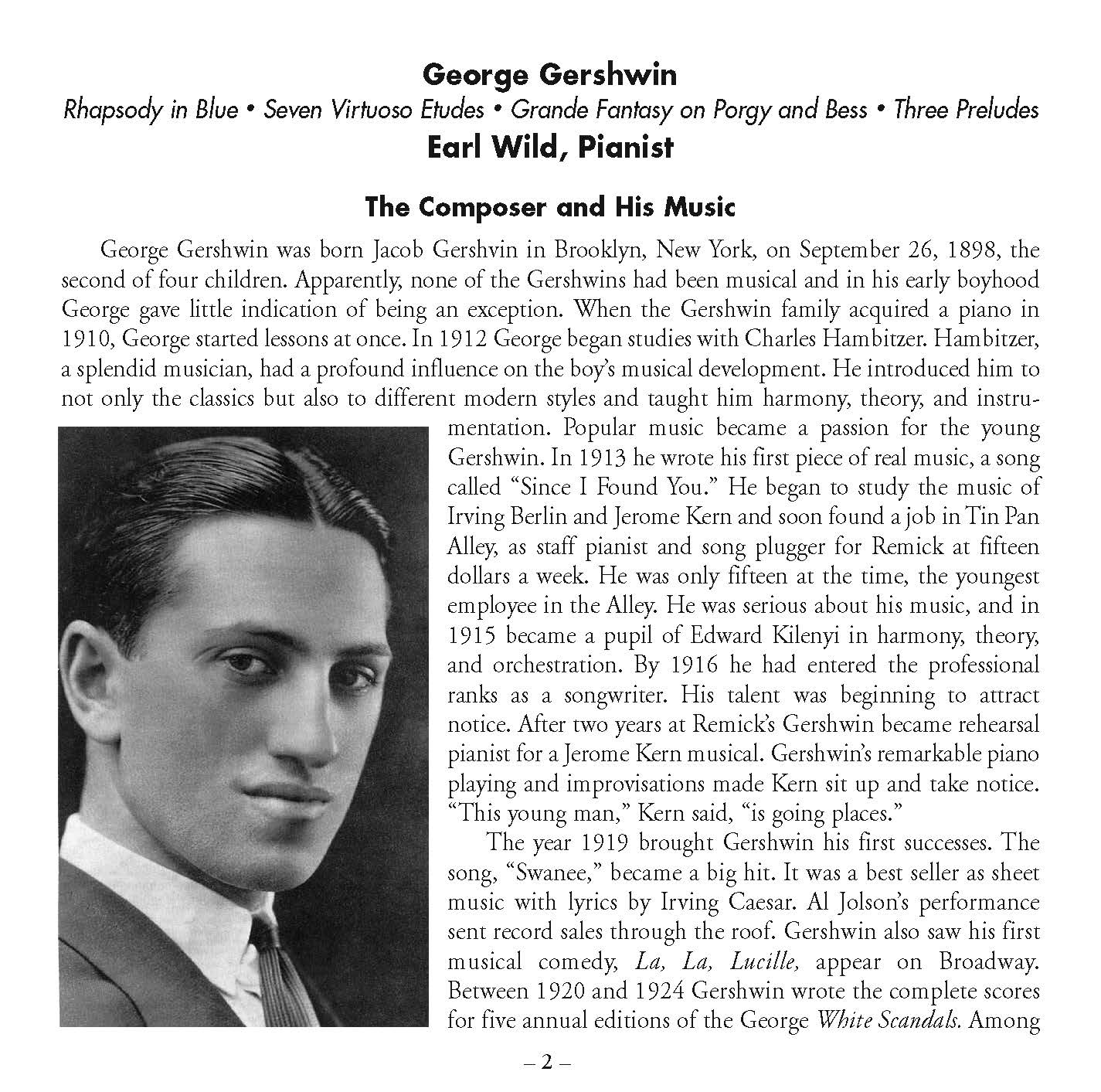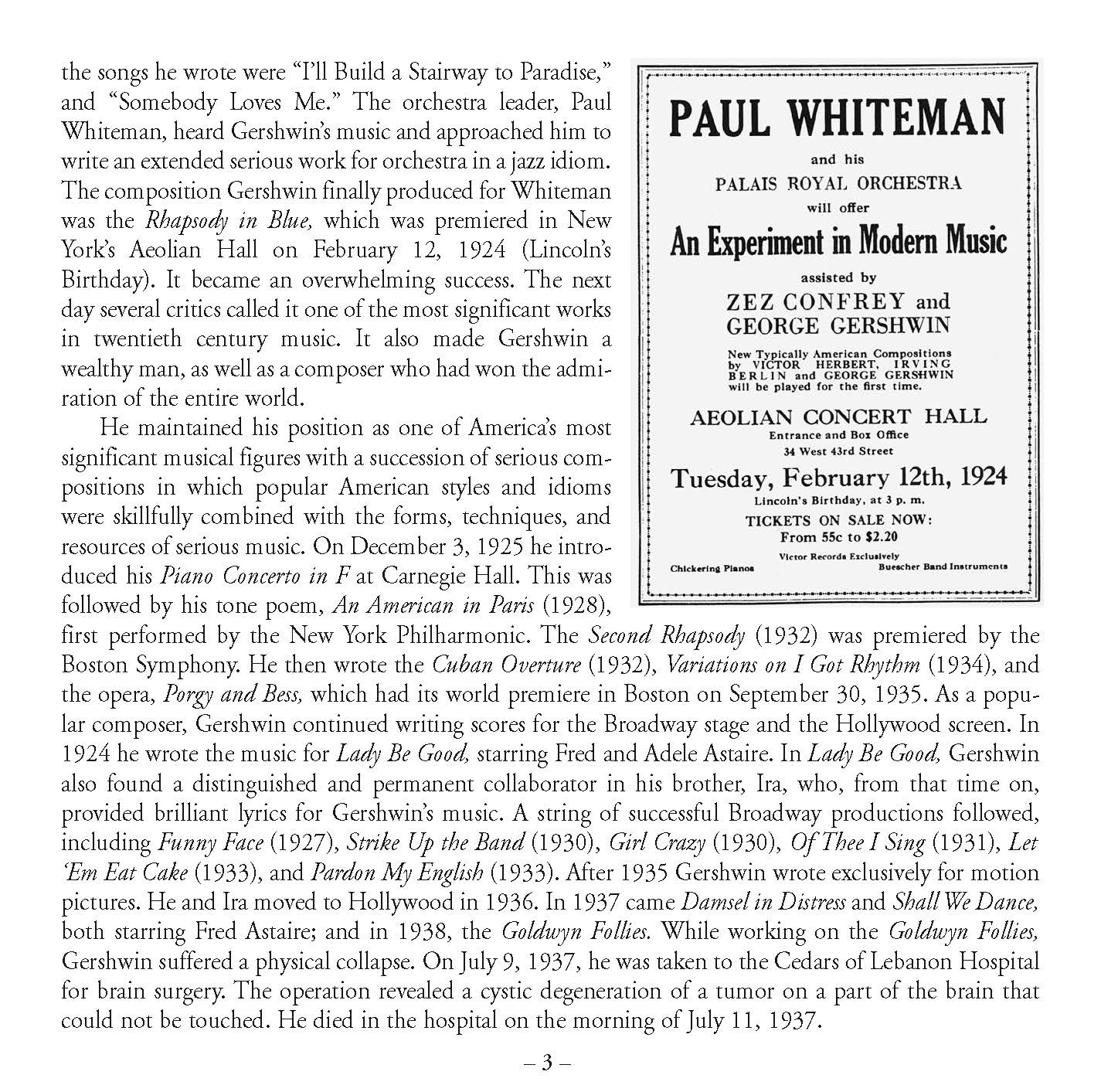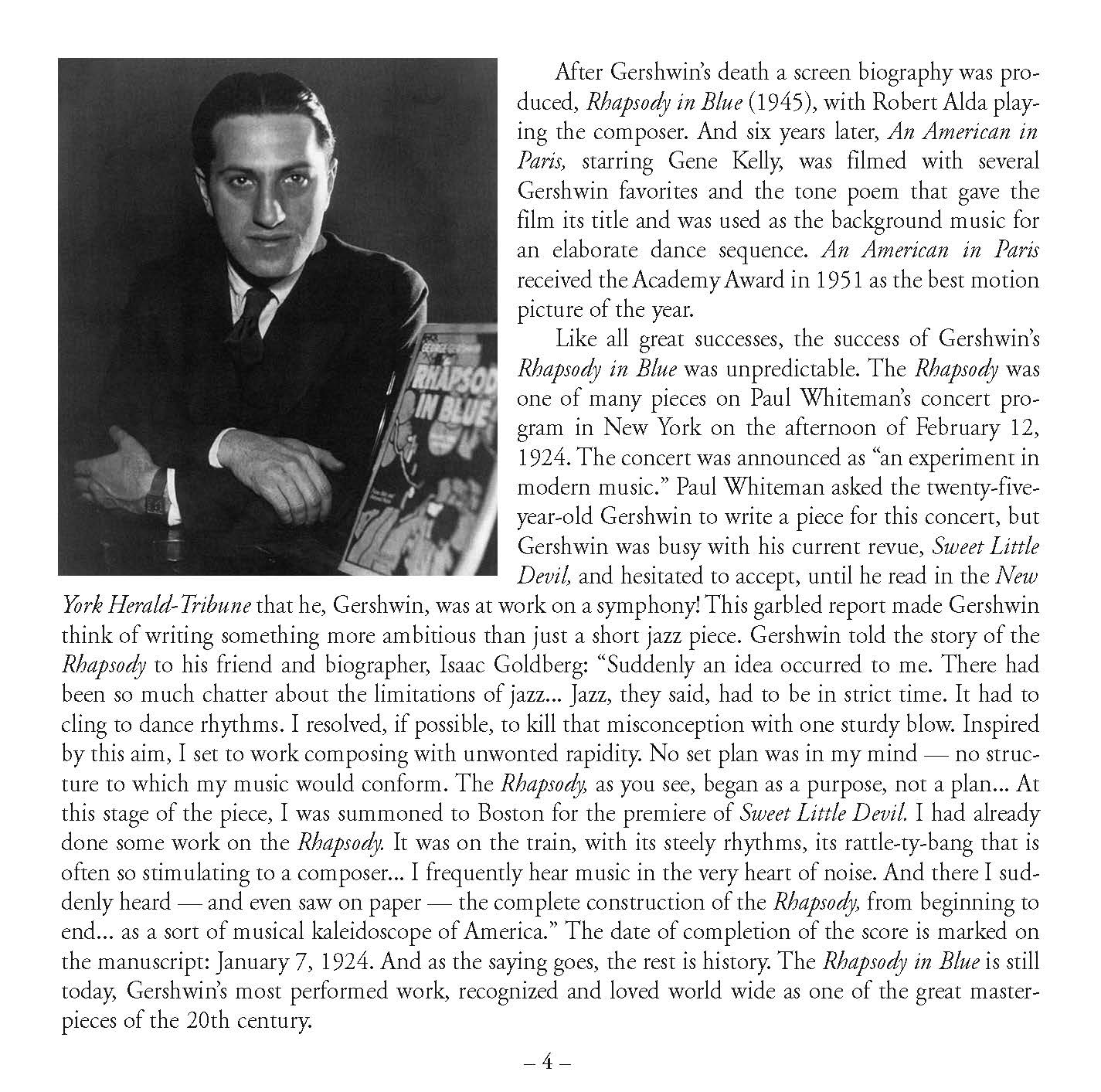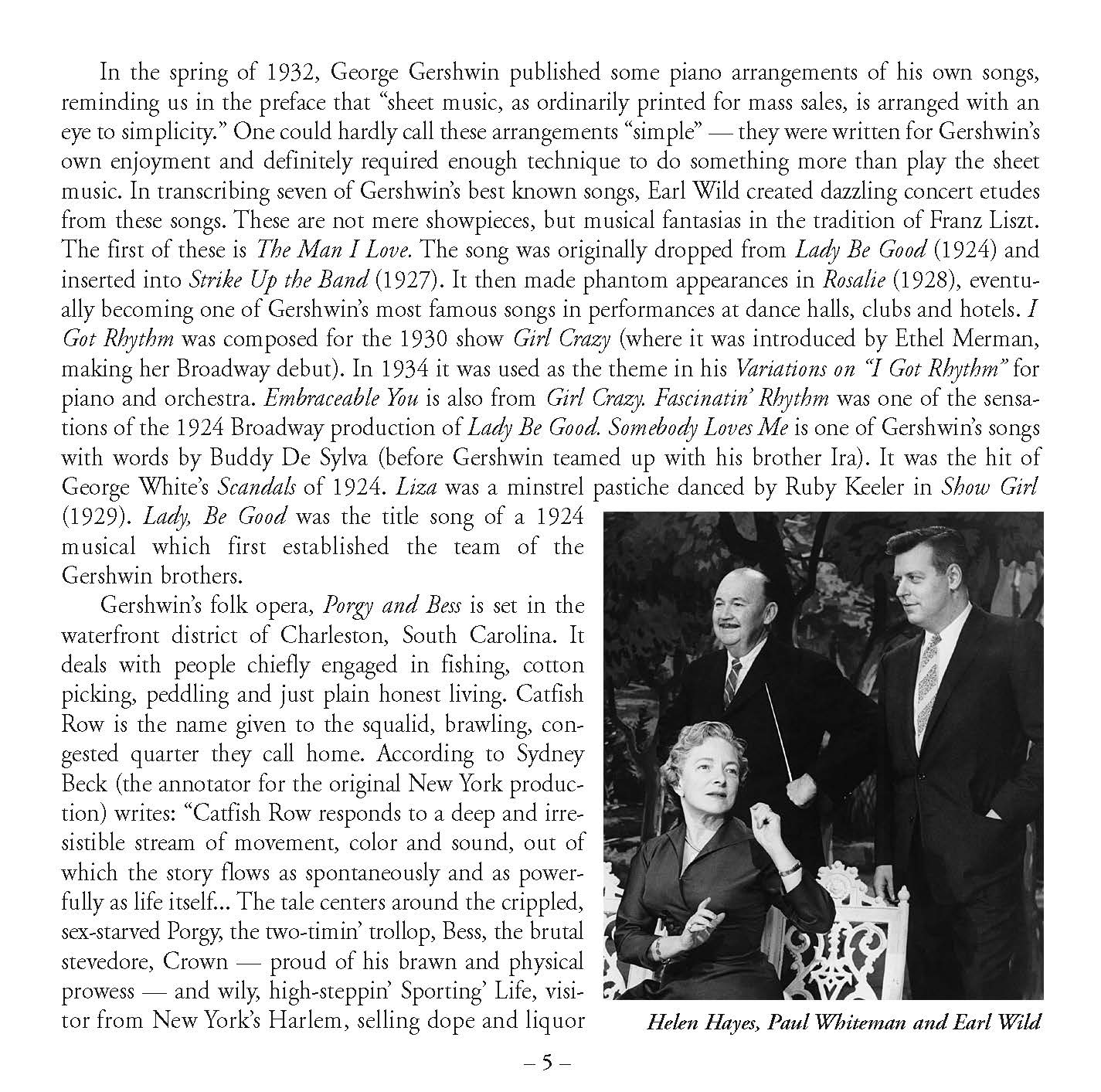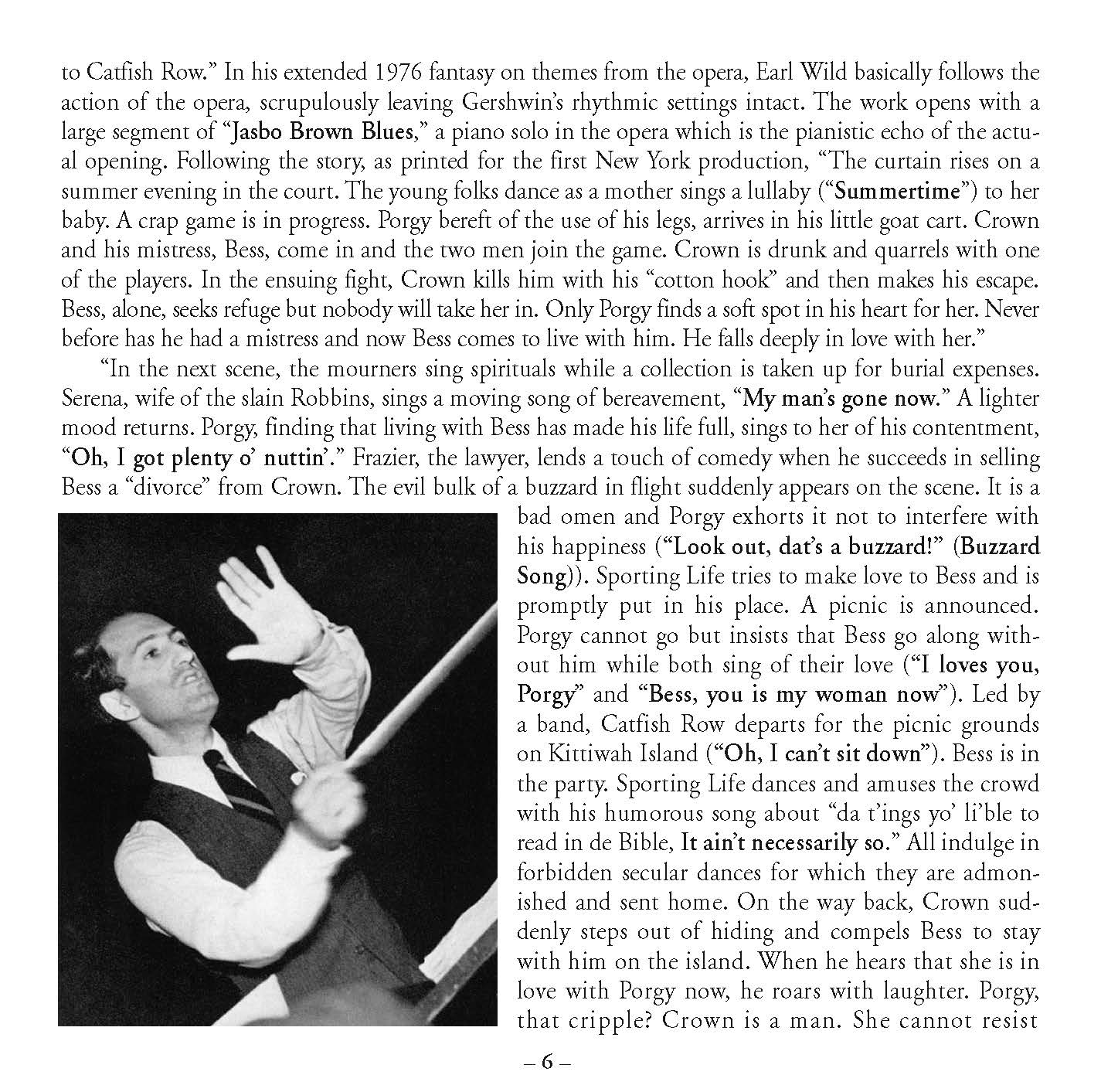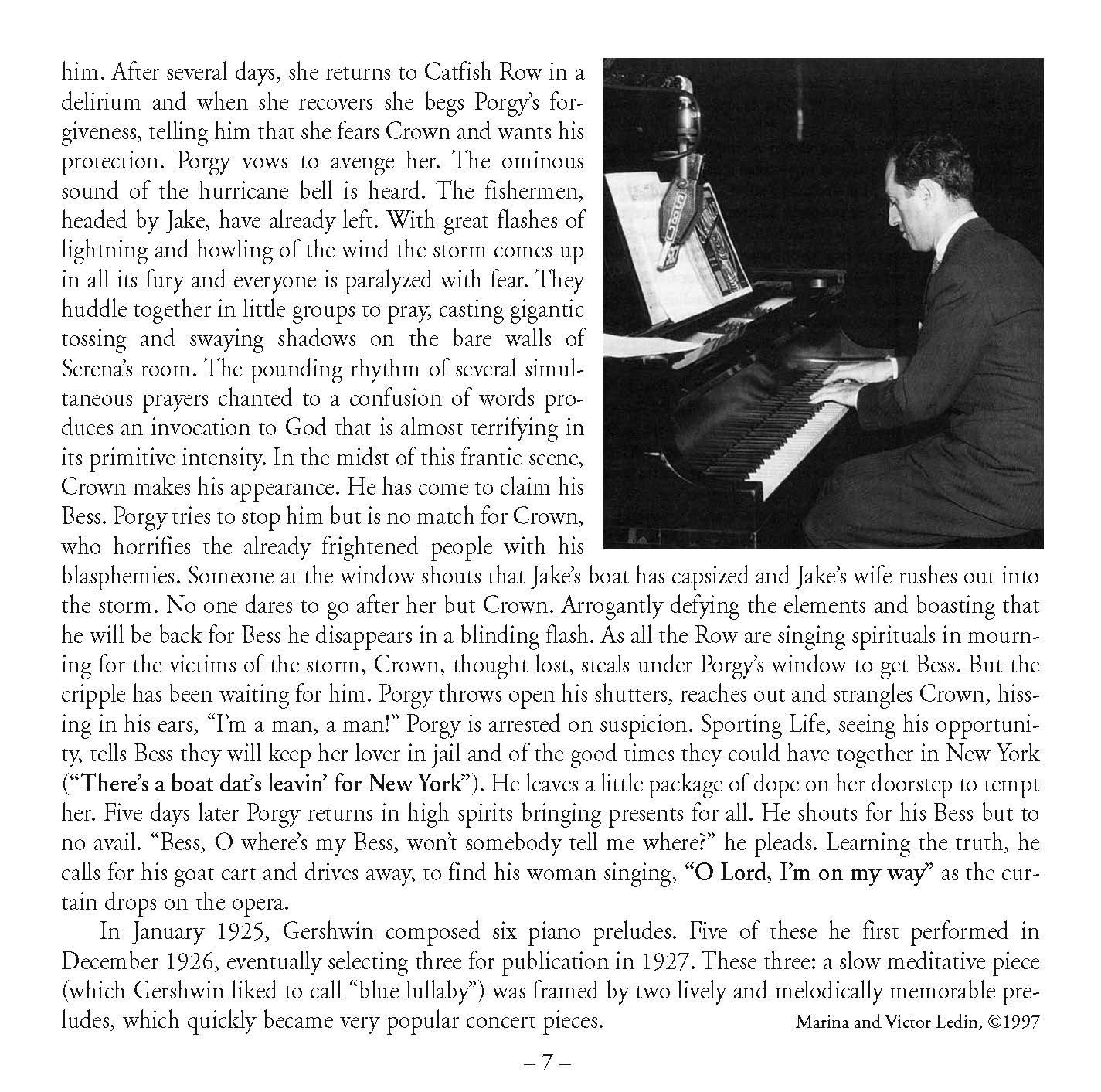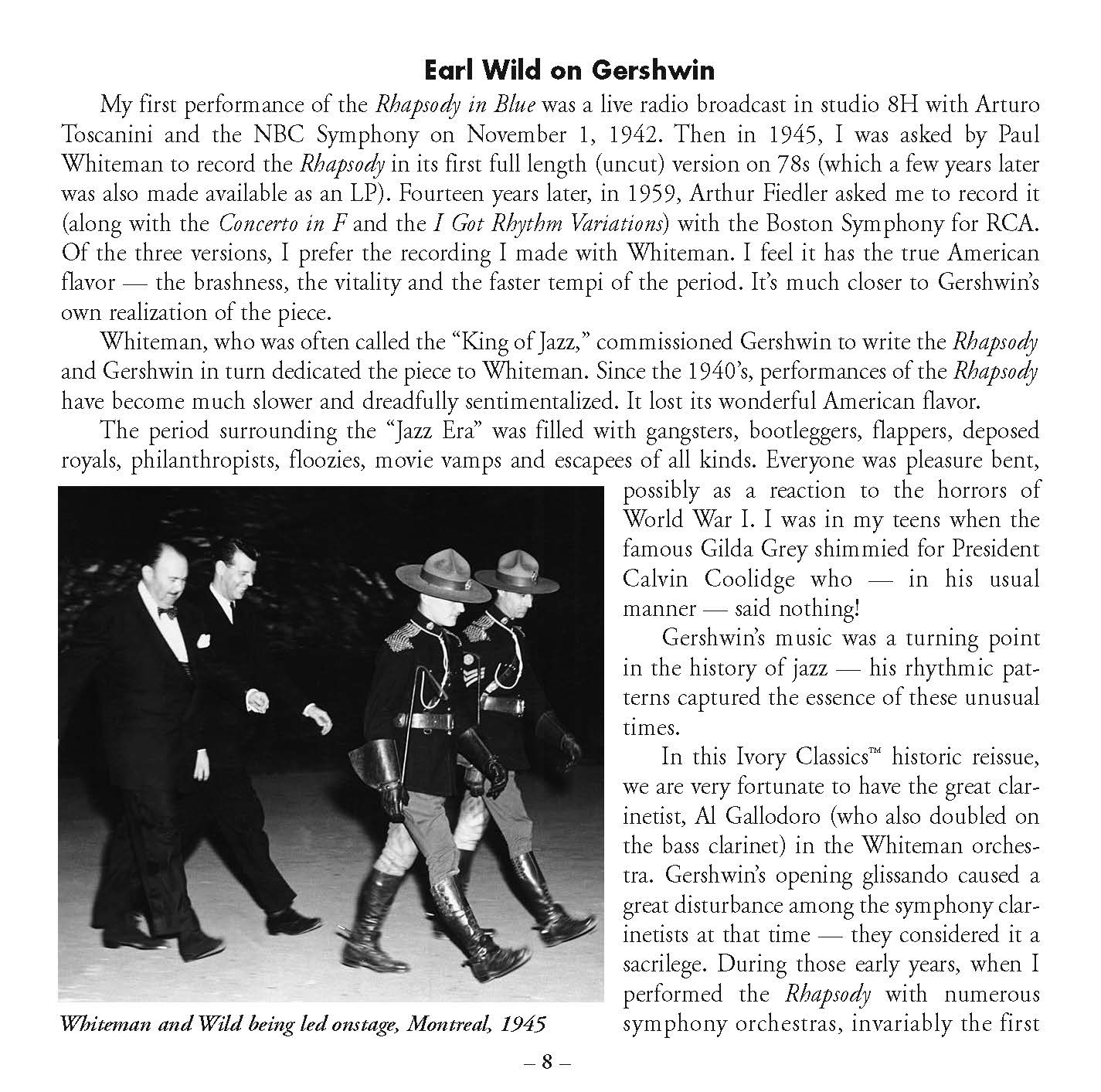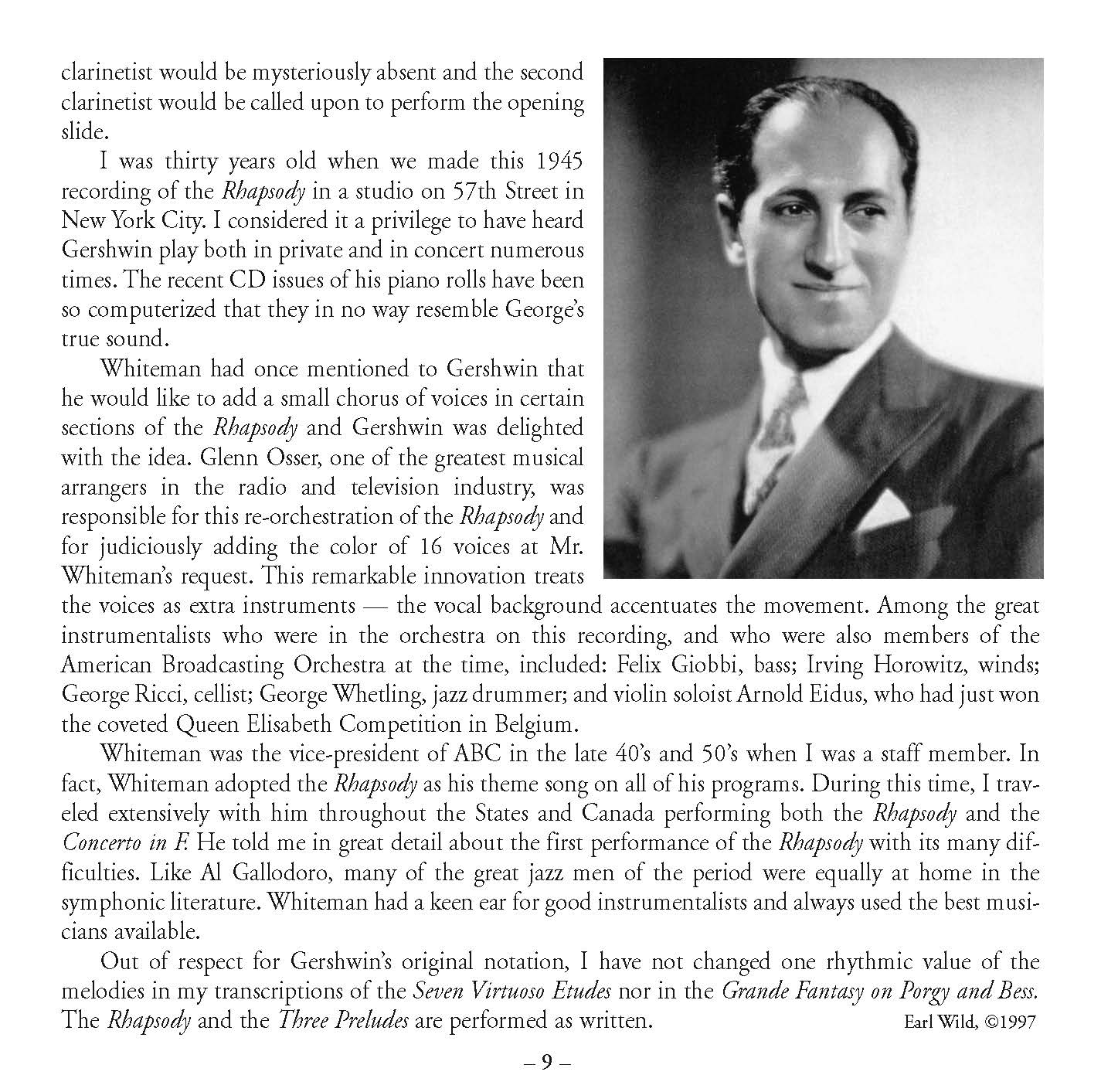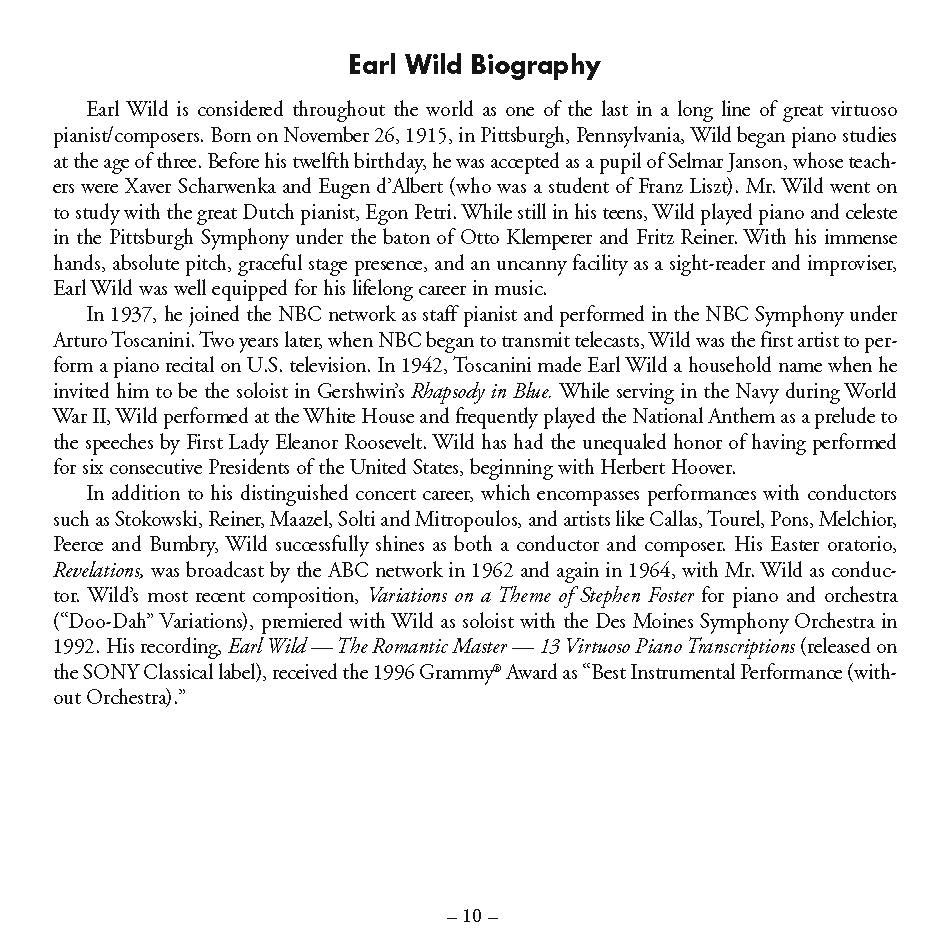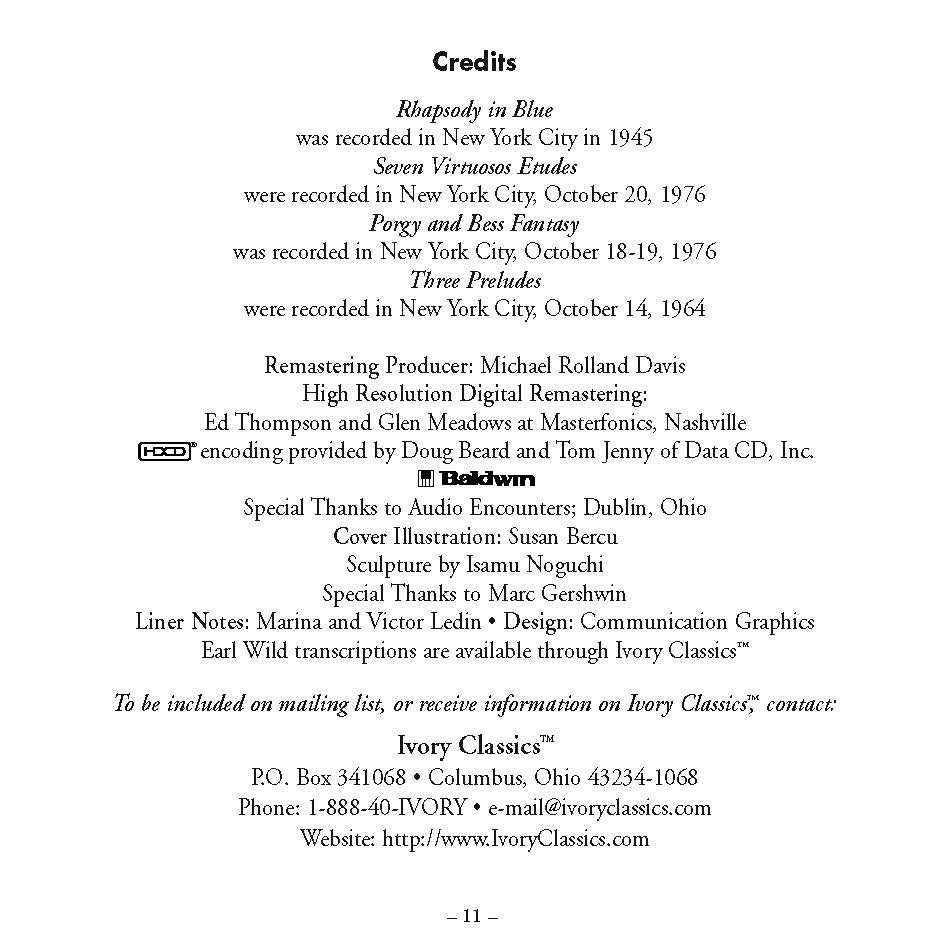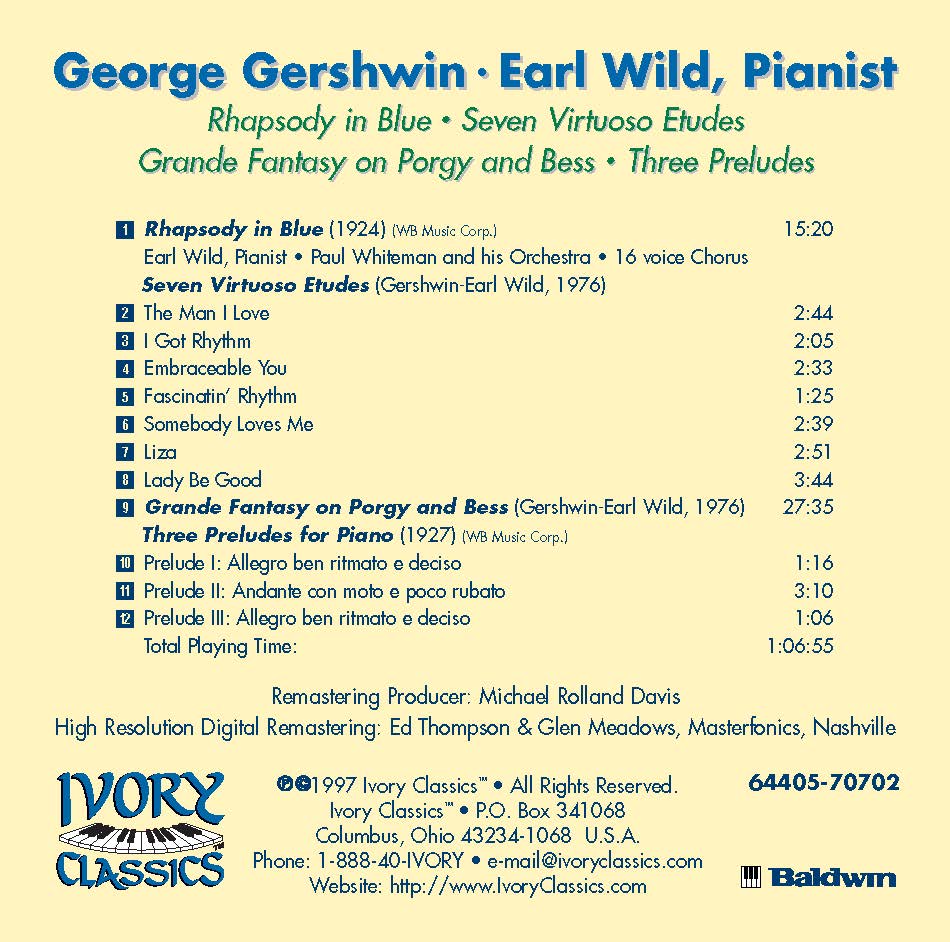1
/
of
12
Earl Wild Plays Gershwin
Earl Wild Plays Gershwin
Regular price
$15.00 CAD
Regular price
Sale price
$15.00 CAD
Unit price
/
per
Couldn't load pickup availability
Ivory Classics CD-70702
Earl Wild Plays Gershwin
George Gershwin (1898-1937):
Piano: Earl Wild
Producer: Michael Rolland Davis
Engineer: Ed Thompson
Piano: Steinway, Baldwin
Mastered using 20-Bit State-of-the-Art Technology - HDCD Encoded
Earl Wild transcription scores are available here.
This historic Gershwin recording includes the first complete "Rhapsody in Blue" recorded in 1945 with Paul Whiteman and his Orchestra. Also on the disc are Mr. Wild's legendary 1976 performances of his popular piano transcriptions, "Grande Fantasy on Porgy and Bess" and "Seven Virtuoso Etudes". Completing this historic recording are the "Three Preludes" recorded in 1964.
Disc.Reviews
I'm learning a few of the Virtuoso Etudes at the moment (which, by the way, are his famous transcriptions of The Man I Love, I Got Rhythm, Embraceable You, Fascinating Rhythm, Somebody Loves Me, Liza & Lady Be Good) and finding them the biggest challenge I've ever had. I'm also having lots of FUN as well!
But I was astonished when I heard Earl Wild play them at Double the speed I though physically possible...!
Earl Wild is known as the last of the great Virtuosic pianist-composers. At the grand age of 90 now, he is still stunning.
The greatest recording of Earl Wild playing George Gershwin you'll ever hope to have. A fantastic listen. I spend hours listening.
Fantastic for the pianist, the aspiring pianist, the Gershwin-lover, and/or the enthusiastic listener - It doesn't matter.
A historic and virtuosic delight!
Amazon.com, Jan. 2005
Earl Wild's first performance of Rhapsody in Blue was a live 1942 broadcast with Toscanini, which effectively typecast the young pianist as a Gershwin specialist. Three years later Wild was invited by Paul Whiteman (who premiered and first recorded the work with the composer at the keyboard) to participate in the work's first uncut recording, reissued for the first time here on CD. True, Glenn Osser's re-orchestration with an added 16-voice choir borders on kitsch; and Whiteman's conducting, though snappily paced, has the subtlety of an avalanche. Wild's breezy fingerwork and stylish flair, however, saves the day. The pianist serves up his own Seven Virtuoso Etudes on Gershwin songs and his Grande Fantasy on Porgy and Bess with slightly more dash and abandon in these 1976 recordings than his later Chesky remakes, and he delivers the Three Preludes with uncluttered directness. A delicious reissue.
Classics Today, Dec. 2002
CD representation of octogenarian pianist Earl Wild is enhanced by a number of recent issues on the new label, Ivory Classics. Most intriguing of the three CDs is the all-Gershwin disc featuring Wild's 1945 Victor recording of Rhapsody in Blue with Paul Whiteman and his Orchestra. Wild has closer identification with this music than any other pianist; he first performed it with Arturo Toscanini and the NBC Symphony in 1942, heard Gershwin play it many times, and has been soloist in countless concert performances. Whiteman, who had commissioned Rhapsody, wished to record it and requested the addition of a wordless 16-voice chorus, an idea enthusiastically endorsed by Gershwin. Glen Osser made this arrangement using voices as instruments heard often throughout the Rhapsody. It works and really creates an atmosphere of the '40s; it is surprising that this version hasn't been recorded since. Wild plays with enormous energy; there is vigor in this performance not heard in other more recent recordings. Even Wild's superb 1959 recording with Arthur Fiedler and the Boston "Pops" (RCA Living Stereo 68792) cannot match the spirit of the 1945 version. Ivory Classics' transfer from the 78s (now more than a half-century old!!) has been miraculously well accomplished. The CD also contains other Gershwin performances by Wild, his "virtuoso etude" treatment of seven songs, and Grande Fantasy on Porgy and Bess, all recorded in 1976, music he later recorded for Chesky. This is an essential CD for Gershwin buffs.
Classic CD, Jan. 2002
If authenticity means stripping off the varnish, then you couldn't get more authentic than Earl Wild's Rhapsody in Blue. This 1945 recording conducted by Paul Whiteman (who commissioned the piece in 1924) is a revelation. It's brassy, brisk and brash as a Busby Berkeley show, and makes every other performance you've ever heard seem over-tasteful. Wild is a kind of Hemingway of the piano - his playing is a demonstration of machismo. It works fabulously.
BBC Music Magazine, Sep. 1999
American pianist Earl Wild, now in his 80s, is one of the few remaining pianists in the hallowed romantic tradition. His artistic lineage is impressive: Selmar Janson, Wild's primary teacher, studied with Eugen d'Albert, who was a distinguished pupil of the great Franz Liszt. For some reason, though, Wild has not achieved the kind of status his virtuosity and musicianship deserve.
Ivory Classics, a new label based in Ohio, aims to fight this injustice. They've been issuing some lovely discs, bringing long-forgotten gems back into the catalog as well as releasing some brand-new recordings. This Gershwin disc is an example of the former. The performance of Rhapsody in Blue was recorded back in 1945 (just two decades after the work's premiere), featuring Paul Whiteman and his Orchestra, the original dedicatees of this classic work. It's an energetic performance, and the addition of a small chorus to the ensemble (arranged especially for this recording by Glenn Osser) provides the deliciously extravagant cheesiness of a Hollywood movie musical.
Wild impressively displays his 19th century heritage with his own virtuoso arrangements of seven favorite Gershwin songs and a thirty minute-long Fantasy on themes from 'Porgy and Bess.' If you can imagine Rachmaninov improvising a cocktail lounge-style arrangement of 'I Got Rhythm' then you'll have a good idea of what this stuff sounds like. These recordings were made in the '70s, and they sound warm and clean in these transfers. Rhapsody in Blue has rather consistent distortion, but it's perfectly listenable for those used to such historical documents.
Andrew Farach-Colton, Amazon.com, Feb. 1999
The greatest praise must be reserved for Earl Wild's piano transcriptions. By anyone's standards, they're a marvel, a thing of real beauty, as good if not better than anything Liszt might have written.
American Record Guide, Aug. 1998
This disc is very much a collector's piece. Whiteman and Wild's reading of the 'Rhapsody,' is extraordinarily vigorous and alive. It firecrackers out across the years in this fine transfer from the 78 rpm original.
Classic CD, Jul. 1998
A terrific record that will appeal to anyone with the slightest interest in Gershwin. The performances are stunningly idiomatic. Wild's own Etudes, pianistically riveting, pay homage to Gershwin's original songs; the performances couldn't be bettered.
Gramophone, Jul. 1998
In Rhapsody in Blue, the trumpet comes in with a perceptible swagger and Wild later appears, playing crisply and powerfully. This is a dashing exciting performance. Wild's piano transcriptions show his understanding of Gershwin's unique piano style, its energy, and verve and yet they beautifully reflect Wild's own musical personality.
Fanfare Magazine, Apr. 1998
This disc restores to the catalogs one of the least-known but most intriguing items in Earl Wild's discography: his 1945 collaboration with Paul Whiteman in Gershwin's Rhapsody in Blue. Earl Wild's seven 'Virtuoso Etudes', on Gershwin themes, represent a type of captivating, creative pianism that only someone of Wild's ultra sophisticated virtuosity could offer.
International Piano, Dec. 1997
View full details
Earl Wild Plays Gershwin
George Gershwin (1898-1937):
Piano: Earl Wild
Producer: Michael Rolland Davis
Engineer: Ed Thompson
Piano: Steinway, Baldwin
Mastered using 20-Bit State-of-the-Art Technology - HDCD Encoded
Earl Wild transcription scores are available here.
This historic Gershwin recording includes the first complete "Rhapsody in Blue" recorded in 1945 with Paul Whiteman and his Orchestra. Also on the disc are Mr. Wild's legendary 1976 performances of his popular piano transcriptions, "Grande Fantasy on Porgy and Bess" and "Seven Virtuoso Etudes". Completing this historic recording are the "Three Preludes" recorded in 1964.
Disc.Reviews
I'm learning a few of the Virtuoso Etudes at the moment (which, by the way, are his famous transcriptions of The Man I Love, I Got Rhythm, Embraceable You, Fascinating Rhythm, Somebody Loves Me, Liza & Lady Be Good) and finding them the biggest challenge I've ever had. I'm also having lots of FUN as well!
But I was astonished when I heard Earl Wild play them at Double the speed I though physically possible...!
Earl Wild is known as the last of the great Virtuosic pianist-composers. At the grand age of 90 now, he is still stunning.
The greatest recording of Earl Wild playing George Gershwin you'll ever hope to have. A fantastic listen. I spend hours listening.
Fantastic for the pianist, the aspiring pianist, the Gershwin-lover, and/or the enthusiastic listener - It doesn't matter.
A historic and virtuosic delight!
Amazon.com, Jan. 2005
Earl Wild's first performance of Rhapsody in Blue was a live 1942 broadcast with Toscanini, which effectively typecast the young pianist as a Gershwin specialist. Three years later Wild was invited by Paul Whiteman (who premiered and first recorded the work with the composer at the keyboard) to participate in the work's first uncut recording, reissued for the first time here on CD. True, Glenn Osser's re-orchestration with an added 16-voice choir borders on kitsch; and Whiteman's conducting, though snappily paced, has the subtlety of an avalanche. Wild's breezy fingerwork and stylish flair, however, saves the day. The pianist serves up his own Seven Virtuoso Etudes on Gershwin songs and his Grande Fantasy on Porgy and Bess with slightly more dash and abandon in these 1976 recordings than his later Chesky remakes, and he delivers the Three Preludes with uncluttered directness. A delicious reissue.
Classics Today, Dec. 2002
CD representation of octogenarian pianist Earl Wild is enhanced by a number of recent issues on the new label, Ivory Classics. Most intriguing of the three CDs is the all-Gershwin disc featuring Wild's 1945 Victor recording of Rhapsody in Blue with Paul Whiteman and his Orchestra. Wild has closer identification with this music than any other pianist; he first performed it with Arturo Toscanini and the NBC Symphony in 1942, heard Gershwin play it many times, and has been soloist in countless concert performances. Whiteman, who had commissioned Rhapsody, wished to record it and requested the addition of a wordless 16-voice chorus, an idea enthusiastically endorsed by Gershwin. Glen Osser made this arrangement using voices as instruments heard often throughout the Rhapsody. It works and really creates an atmosphere of the '40s; it is surprising that this version hasn't been recorded since. Wild plays with enormous energy; there is vigor in this performance not heard in other more recent recordings. Even Wild's superb 1959 recording with Arthur Fiedler and the Boston "Pops" (RCA Living Stereo 68792) cannot match the spirit of the 1945 version. Ivory Classics' transfer from the 78s (now more than a half-century old!!) has been miraculously well accomplished. The CD also contains other Gershwin performances by Wild, his "virtuoso etude" treatment of seven songs, and Grande Fantasy on Porgy and Bess, all recorded in 1976, music he later recorded for Chesky. This is an essential CD for Gershwin buffs.
Classic CD, Jan. 2002
If authenticity means stripping off the varnish, then you couldn't get more authentic than Earl Wild's Rhapsody in Blue. This 1945 recording conducted by Paul Whiteman (who commissioned the piece in 1924) is a revelation. It's brassy, brisk and brash as a Busby Berkeley show, and makes every other performance you've ever heard seem over-tasteful. Wild is a kind of Hemingway of the piano - his playing is a demonstration of machismo. It works fabulously.
BBC Music Magazine, Sep. 1999
American pianist Earl Wild, now in his 80s, is one of the few remaining pianists in the hallowed romantic tradition. His artistic lineage is impressive: Selmar Janson, Wild's primary teacher, studied with Eugen d'Albert, who was a distinguished pupil of the great Franz Liszt. For some reason, though, Wild has not achieved the kind of status his virtuosity and musicianship deserve.
Ivory Classics, a new label based in Ohio, aims to fight this injustice. They've been issuing some lovely discs, bringing long-forgotten gems back into the catalog as well as releasing some brand-new recordings. This Gershwin disc is an example of the former. The performance of Rhapsody in Blue was recorded back in 1945 (just two decades after the work's premiere), featuring Paul Whiteman and his Orchestra, the original dedicatees of this classic work. It's an energetic performance, and the addition of a small chorus to the ensemble (arranged especially for this recording by Glenn Osser) provides the deliciously extravagant cheesiness of a Hollywood movie musical.
Wild impressively displays his 19th century heritage with his own virtuoso arrangements of seven favorite Gershwin songs and a thirty minute-long Fantasy on themes from 'Porgy and Bess.' If you can imagine Rachmaninov improvising a cocktail lounge-style arrangement of 'I Got Rhythm' then you'll have a good idea of what this stuff sounds like. These recordings were made in the '70s, and they sound warm and clean in these transfers. Rhapsody in Blue has rather consistent distortion, but it's perfectly listenable for those used to such historical documents.
Andrew Farach-Colton, Amazon.com, Feb. 1999
The greatest praise must be reserved for Earl Wild's piano transcriptions. By anyone's standards, they're a marvel, a thing of real beauty, as good if not better than anything Liszt might have written.
American Record Guide, Aug. 1998
This disc is very much a collector's piece. Whiteman and Wild's reading of the 'Rhapsody,' is extraordinarily vigorous and alive. It firecrackers out across the years in this fine transfer from the 78 rpm original.
Classic CD, Jul. 1998
A terrific record that will appeal to anyone with the slightest interest in Gershwin. The performances are stunningly idiomatic. Wild's own Etudes, pianistically riveting, pay homage to Gershwin's original songs; the performances couldn't be bettered.
Gramophone, Jul. 1998
In Rhapsody in Blue, the trumpet comes in with a perceptible swagger and Wild later appears, playing crisply and powerfully. This is a dashing exciting performance. Wild's piano transcriptions show his understanding of Gershwin's unique piano style, its energy, and verve and yet they beautifully reflect Wild's own musical personality.
Fanfare Magazine, Apr. 1998
This disc restores to the catalogs one of the least-known but most intriguing items in Earl Wild's discography: his 1945 collaboration with Paul Whiteman in Gershwin's Rhapsody in Blue. Earl Wild's seven 'Virtuoso Etudes', on Gershwin themes, represent a type of captivating, creative pianism that only someone of Wild's ultra sophisticated virtuosity could offer.
International Piano, Dec. 1997

